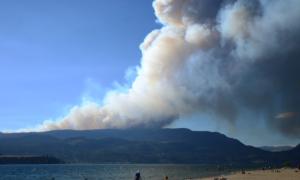Wildfires have raged across North America in 2023, bringing devastating loss of life, property, and air quality.
From Canada’s smoke-filled skies over the Northeast this summer to the inferno in Lahaina, Hawaii, that claimed over 100 lives, major fire disasters have struck swiftly and with little warning.
Lahaina: No Warning and No Way Out
West Maui’s only escape route was filled with fleeing vehicles that met a barricade blocking Highway 30, the Associated Press reported. Though intended to mitigate risks like downed power lines, the road closure trapped residents as flames engulfed Lahaina in one of history’s deadliest wildfires. An unconfirmed FBI list shows over 1,000 missing, many children.Some died in cars, others while fleeing on foot. Survivors escaped by breaking rules, swerving around barricades, or taking backroads. One climbed a dirt road to safety.

Wildfire Prep Begins With Red Flag Alerts
Paying attention to the National Weather Service’s red flag warnings signaling high fire risk conditions is crucial, Ms. Steinberg said.“[Maui residents] had multiple days of a red flag warning, meaning if there is an ignition and a fire begins, it is likely to spread rapidly and perhaps have serious impacts,” she added. “So that’s intended to have people on their guard.”
These warnings advise precautions like avoiding sparks and prompt authorities to ban open flames.
But people often ignore such warnings, as occurred before recent disasters like the Tubbs Fire in California and Gatlinburg fires in Tennessee, Ms. Steinberg said.
How to Prepare for an Emergency
Over 70,000 communities and 44 million homes face wildfire risks where vegetation meets urban areas, called the wildland-urban interface. The U.S. Forest Service reports wildfires destroyed over 35,000 structures over the past decade.In addition to paying attention to red flag warnings, people must be ready to evacuate their homes for an extended period.
“You'd want to have a go-kit, an emergency kit,” Ms. Steinberg said. “Some emergency managers will talk about the three P’s: pills, pets, and pictures.”
Practice evacuation drills, like packing up in 10 minutes. Such preparedness steps can save lives if wildfire strikes your neighborhood.
Protect Your Home Against Flames
Wildfire preparedness also involves protecting homes near wooded areas where fire naturally occurs.
If fire is part of your area’s ecosystem, take steps to make your home ignition-resistant, Ms. Steinberg recommended.
1. Routinely Remove Flammable Debris From Gutters
“Anything that could catch fire, you don’t want touching the house,” Ms. Steinberg said. This includes organic mulch landscaping, which poses a fire risk.2. Do Not Wet Down Your Home
Firefighters don’t want untrained people staying behind, Ms. Steinberg said.“Being exposed to this kind of heat, flames, and gases is a bad situation,” she added. “This is how people get killed in wildfires.” Attempting to wet down your home as fire nears wastes precious escape time without much benefit. In fact, it’s taking away the time you need to get out of harm’s way.
3. Prepare in the Off-Season
Trying to wet your home as the fire approaches is ineffective, Ms. Steinberg said. It is better to fireproof in advance before fire season.Use the off-season to remove debris, seal cracks, and ensure your roof and other materials are noncombustible. “Make sure if you’re going to go replace your roof, you’ve done it the right way, and you’ve done it with a noncombustible assembly.”
Dealing With Burns
Burns are almost inevitable in wildfires.Have within reach antibiotic ointments and gauze bandages to treat minor burns, Dr. Michael Cooper, director of Northwell’s regional burn center at Staten Island University Hospital, told The Epoch Times.
“The initial treatment of the wound would be to clean it softly, pat it dry, and then place the topical antibiotic cream [on it] and dry gauze,” he added.
Seeking medical advice is wise if burns cover over 15 percent of the body, as significant fluid loss can lead to dehydration.
Get immediate professional care for third-degree burns exceeding 8 percent of the body or if an entire arm or half a leg is severely burned, as skin grafting surgery may be required. “Many times, one does need surgery to have that burn skin removed," Dr. Cooper said.
Smoke Inhalation Can Kill
Smoke inhalation poses a grave threat. Enclosed, smoky areas contain toxic gases like carbon monoxide, which restricts breathing and decreases oxygen, Dr. Cooper said.Most casualties in building fires are due to smoke inhalation, not burns, he added. Cyanide released from burning materials also proves lethal.
“A lot of things that burn will have cyanide, so it’s the carbon monoxide and the cyanide that are the big killers in enclosed space.”







